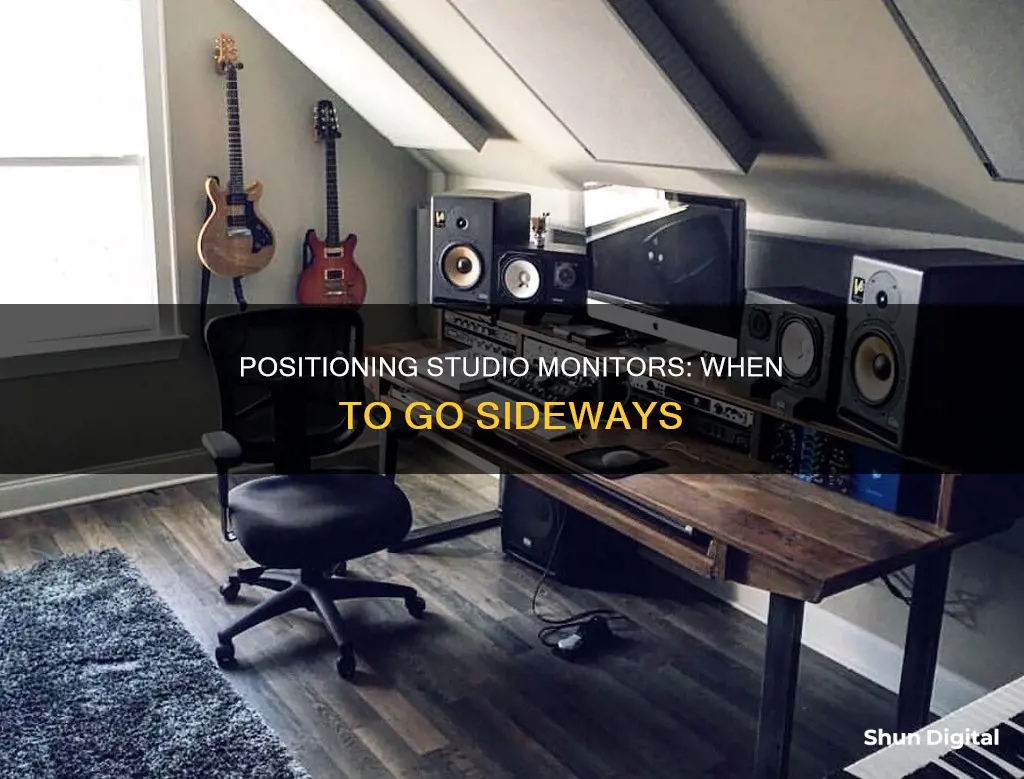
Studio monitors are designed to be placed either vertically or horizontally, depending on the model. While some speakers are designed to be placed on their side, others are meant to be placed vertically. Placing a vertically designed speaker on its side can disrupt the dispersion of sound, causing a narrow sweet spot and an unstable stereo image. This can also cause issues with cooling for active speakers and impact the frequency response in the bass region. However, if your monitor placement is already compromised, changing the orientation may improve the sound. It is recommended to experiment with different placements and use your ears to decide which setup sounds the best.
| Characteristics | Values |
|---|---|
| Speaker design | Speakers are designed to be placed either vertically or horizontally. |
| Speaker placement | Speakers should be placed on their sides if they are designed to be compatible with both placements. |
| Speaker orientation | Speakers should be placed with the tweeter above the woofer. |
| Speaker angle | Speakers should be angled towards the listening position at an angle of around 30 degrees. |
| Speaker distance | Speakers should be placed at a minimum distance of 20-30 cm and a maximum distance of 60-90 cm from the walls. |
| Room shape | In a rectangular room, speakers should be placed on the short wall to minimise reflections from the side walls. |
| Room setup | The setup should be placed in the front area of the room, with the listening position centred relative to the wall. |
| Stereo image | Speakers should be placed symmetrically to maintain a balanced stereo image. |
| Acoustic treatment | Acoustic treatment can be used to improve the accuracy of the mixing environment. |
What You'll Learn
- Studio monitors are designed to function optimally when placed vertically or horizontally
- Speakers with tweeters above woofers have wide horizontal and narrow vertical dispersion
- Sideways monitors will have a smaller left-right sweet spot
- Vertical monitors placed on their side will spread more sound up and down
- Acoustic treatment can be challenging, but monitor placement can help achieve a good mixing environment

Studio monitors are designed to function optimally when placed vertically or horizontally
The dispersion of the high-frequency driver is a significant factor in the optimal placement of studio monitors. The HF driver in most cases is designed to spread sound wider from left to right (horizontally) than up and down (vertically). This creates a wider sweet spot. When a vertical monitor is turned on its side, the sweet spot narrows, and the tweeter directs more sound towards the ceiling and floor, which may cause acoustic anomalies.
Additionally, active monitors with cooling heat sinks on the back may experience issues with proper airflow if placed on their sides. Therefore, it is generally recommended to follow the manufacturer's placement guidelines. However, if your studio setup is already compromised, changing the monitor orientation may improve the overall acoustics.
To create a balanced stereo image and a more reliable frequency response, the listening position should be centred relative to the wall the speakers are facing. The monitors should be placed at an equal distance from the walls to their sides and back, with different distances between the two. It is also important to avoid placing monitors directly on hard surfaces, like a console or desktop, to prevent unwanted reflections and vibrations.
In summary, studio monitors are designed to function optimally when placed according to their specific design and the acoustic characteristics of the room. The placement should also consider the listener's position to create an ideal equilateral triangle, known as the "sweet spot".
Asus Monitors: LED-Only or Not?
You may want to see also

Speakers with tweeters above woofers have wide horizontal and narrow vertical dispersion
Speakers with tweeters above woofers are designed to have a wider horizontal dispersion and a narrower vertical dispersion. This means that they spread sound wider from left to right, but limit the up-and-down spread. This creates a generous left-right sweet spot, and a tonally balanced spectrum of room reflections.
The wide horizontal dispersion is beneficial as it allows for a broader listening window, with a gradual and uniform fall-off for side-radiated sound. This is called "controlled directivity". The narrower vertical dispersion is also advantageous as it lessens reflections from your desk and ceiling.
When speakers with this design are turned on their side, the horizontal and vertical dispersion patterns are affected. The sweet spot becomes less wide, and there is a noticeable "pinch" in the mid-frequencies, which changes the way many instruments sound. Reflections from the desk and ceiling are also likely to be worsened.
Therefore, it is generally not recommended to place speakers with tweeters above woofers on their side. Instead, it is best to follow the manufacturer's recommendations for placement. If the monitor placement in your studio is already compromised, changing the monitor orientation may result in fewer problems. Alternatively, you can try placing the speakers vertically but upside down, with the tweeter on the bottom and the woofer on the top.
Blind Spot Monitoring: Lowering Insurance with Safety Tech
You may want to see also

Sideways monitors will have a smaller left-right sweet spot
Studio monitors are designed to be placed either vertically or horizontally, depending on their make. While some monitors can be placed in either orientation, many are designed to be used only vertically. When placed horizontally, the width of the sweet spot narrows, and the tweeter throws more sound towards the ceiling and the floor. This can cause acoustical anomalies.
Speakers with the tweeter above the woofer have wide horizontal dispersion and narrower vertical dispersion. When these monitors are mounted sideways, their horizontal and vertical dispersion patterns are affected. This means that sideways monitors will have a smaller left-right sweet spot. If you move left and right, you will also experience the mid-frequency "pinch", which changes the way many instruments sound.
To avoid this, you can tilt your monitors forward by up to 15 degrees so that the tweeters point towards your ears. Alternatively, you can place your monitors vertically but upside down, with the tweeter on the bottom and the woofer on the top.
Best HDMI Monitor Options for Your P3P
You may want to see also

Vertical monitors placed on their side will spread more sound up and down
While studio monitors are typically designed to be placed either vertically or horizontally, placing them on their side will alter the sound dispersion pattern.
Most studio monitors are designed to spread sound further left and right (in the horizontal plane) than up and down (in the vertical plane). This is to create a wider "sweet spot" and to prevent mixing desk/equipment reflections, providing a more consistent listening experience across the room.
When vertical monitors are placed on their side, the sound dispersion pattern narrows in the horizontal plane and widens in the vertical plane. This means that the tweeter will throw more sound up toward the ceiling and down toward the floor, resulting in a narrower "sweet spot" and potential acoustical anomalies.
Additionally, placing studio monitors on their side can push the woofer and tweeter out of alignment, causing the sound to arrive at your ears at slightly different speeds and resulting in comb filtering and phasing issues. It also moves the woofer closer to the desk or studio monitor stands, which can cause bass frequency response issues.
Therefore, while it is possible to place studio monitors on their side, it is generally not recommended as it can impact the sound dispersion pattern and cause other acoustical issues. It is best to follow the manufacturer's recommendations regarding placement and make adjustments based on the specific setup and requirements of your studio.
Monitoring CPU Usage: Optimizing WordPress Performance
You may want to see also

Acoustic treatment can be challenging, but monitor placement can help achieve a good mixing environment
Monitor placement is essential to ensuring an accurate listening experience. Every room has a set of resonant frequencies that create modes, which are caused by sound reflecting off different surfaces. The effects of these modes depend on the position of the listener, the monitors, and the room's treatment. While acoustic treatment can be daunting, spending time on monitor placement will help you achieve a mixing environment that ensures the best results in different playback situations.
When deciding on the right place in the room, it is not recommended to place your setup in the centre of the room, as that is where the sound is likely to be least reliable. If your setup is intended primarily for making music, place it in the front area of the room, divided into three equal-sized areas. Your listening position should be centred relative to the wall it faces, and your monitors should be equidistant from the walls to their side and back, with different distances between those two. If you have a rectangular room, centre your listening position on one of the long walls to minimise potential reflections from the sidewalls.
To create a balanced stereo image, the speaker placement and listening position should form an equilateral triangle. The monitors should be turned towards the listening position at an angle of around 30 degrees, aligning with the ears of the listener. The tweeter should ideally be at ear level, as this will help you more accurately discern what is happening at the higher end of the frequency spectrum.
Monitor stands are a good investment as they allow you to separate the monitors from the rest of your setup and easily adjust their distance and orientation. If stands are not an option, decouplers or isolation pads can be used to isolate monitors from hard surfaces and mitigate vibrations and resonances.
Removing Rubber Covers from Your ASUS Monitor Easily
You may want to see also
Frequently asked questions
Studio monitors are designed to function optimally when placed either vertically or horizontally. However, it is recommended to follow the manufacturer's guidelines for placement. Putting monitors on their side can impact the dispersion of sound and create a narrower sweet spot.
When studio monitors are placed on their side, the horizontal and vertical dispersion patterns are altered. This results in reduced left-right leeway and a narrower sweet spot. Additionally, the mid-frequency "pinch" becomes more noticeable, altering the sound of various instruments.
Here are some general guidelines for optimal studio monitor placement:
- Refer to the manufacturer's instructions or paperwork to determine the recommended orientation.
- Avoid placing monitors against long, flat walls or in corners to minimise reflections.
- Symmetrical room design and symmetrical left/right speaker placement are ideal for a balanced stereo image.
- Create an equilateral triangle between the speaker placement and listening position to establish the "sweet spot".
- Position the tweeter at ear level to optimise sound dispersion.
- Use stands or isolation pads to separate monitors from hard surfaces and reduce unwanted reflections and vibrations.







